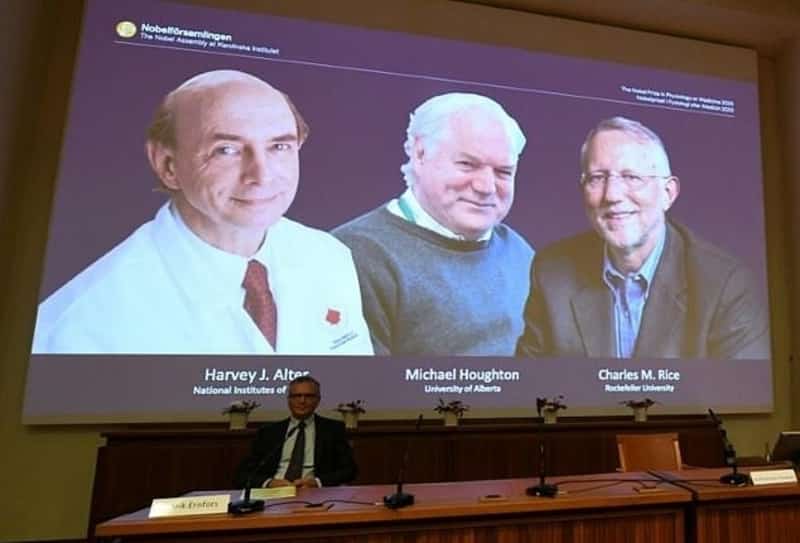Nobel Prize for medicine is awarded to two Americans and a British scientist for discovering hepatitis C in breakthrough that has saved ‘millions of lives’
- Michael Houghton, virologist at Li Ka Shing Centre in Cambridge, one of winners
- Committee said the trio’s finds in the 1980s were ‘a landmark achievement’
- Prior to work, majority of hepatitis cases remained unexplained and un-treatable
Three scientists – including one Briton – who discovered the hepatitis C virus have won the 2020 Nobel Prize for medicine.
The winners of the coveted award are Professor Michael Houghton, a virologist at the Li Ka Shing Centre for Health in Cambridge, and Americans Professor Harvey Alter and Professor Charles Rice.
The Nobel committee said the trio’s finds in the 1980s were ‘a landmark achievement in the ongoing battle against viral diseases’ that have ‘saved millions of lives’.
They will receive a gold medal and split the prize money of $1.1million (£780,000) for their work, which saw the virus formally identified in 1989.
Hepatitis C is a blood-borne virus that infects the liver and is a common cause of liver cancer. It is spread through coming into contact with the blood of someone infected – often drug users who share needles.
THE TRIO’S PRIZE-WINNING RESEARCH
Hepatitis A and B were discovered in the 1960s, but doctors were continuing to find a large number of blood-transfusion patients with hepatitis different to those strains.
This mysterious illness – which became known as ‘non-A, non-B’ hepatitis – could not be identified and medics struggled to develop treatments.
Professor Harvey Alter, while studying transfusion patients at the US National Institutes of Health, was finding a large number with hepatitis that he proved were not caused by other strains.
Michael Houghton – while working at the US pharmaceutical firm Chiron – isolated the genetic make-up of the virus, which helped prove it was a type of flavivirus.
Charles Rice, while at Washington University in St Louis, then injected a genetically manufactured Hepatitis C virus into the liver of chimpanzees to demonstrate how it leads to hepatitis in humans.
Their contributions led to the eventual discovery of hepatitis C in 1989.
By the mid-1990s, new cases of the virus plummeted by 80 per cent in the UK and US thanks to new treatments and blood tests.
WHAT IS HEPATITIS C?
Hepatitis C is inflammation of the liver and there is no preventive vaccine.
There are around three million people in the US and 215,000 people in the UK who are living with chronic hepatitis.
Most aren’t aware that they are infected, according to the CDC.
Spread through contaminated blood, hepatitis C tends to develop into a chronic infection after six months.
The infection attacks the liver, leading to cirrhosis or liver cancer.
Symptoms include:
- Weight loss (without trying)
- Loss of appetite
- Feeling very full after a small meal
- Nausea or vomiting
- An enlarged liver, felt as a mass under the ribs on the right side
- An enlarged spleen, felt as a mass under the ribs on the left side
- Pain in the abdomen or near the right shoulder blade
- Swelling or fluid build-up in the abdomen
- Itching
- Yellowing of the skin and eyes (jaundice)
WHO ARE THE PRIZE-WINNING SCIENTISTS?
Harvey Alter
Harvey Alter is an American virologist who was born in New York City and trained at the University of Rochester in Rochester, New York.
As a young research fellow in 1964, Alter co-discovered the Australian antigen with Professor Baruch Blumberg, which led to the eventual discovery of hepatitis B.
Alter was hired by the National Institutes of Health, Bethesda, Maryland, as a senior investigator in 1969.
He remains at the NIH as a chief of the infectious diseases section and associate director of research in the department of transfusion medicine.
In the mid-1970s, Alter and his research team demonstrated that most hepatitis cases from blood transfusion were not due to hepatitis A and hepatitis B viruses. This work eventually led to the discovery of the hepatitis C virus.
Michael Houghton
Michael Houghton is a British scientist who graduated from the University of East Anglia with a degree in biological sciences in 1972.
He subsequently completed his PhD in biochemistry at King’s College London in 1977.
Houghton was inspired to become a microbiologist after reading about the 19th century French scientist Louis Pasteur.
Pasteur was famous for his remarkable breakthroughs in the causes and prevention of diseases. He reduced mortality from puerperal fever and created the first vaccines for rabies and anthrax.
Houghton while working at the US pharmaceutical firm Chiron in the 1980s isolated the genetic make-up of the hepatitis C virus, which helped prove it was a type of flavivirus, the family of viruses that cause hepatitis.
Charles Rice
Charles Rice is an American virologist who graduated with a Bachelor of Science degree in zoology from University of California in 1974.
In 1981, he received his PhD in biochemistry from the California Institute of Technology, where he studied RNA viruses in the lab of James Strauss.
He remained at Caltech for four years to do postdoctoral research. After his postdoctoral work, Rice moved to the Washington University School of Medicine as an assistant professor in 1986, where he remained until 2001, eventually rising to the rank of professor.
Rice’s lab at the Rockefeller University works to understand virus replication and innate immune responses that limit infection.
Read more at Dailymail.co.uk


